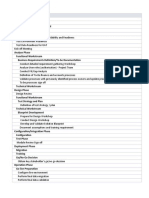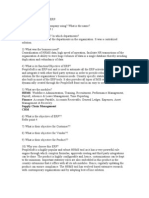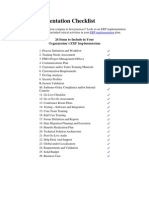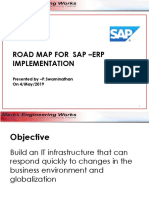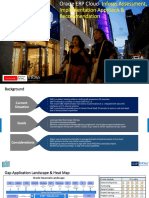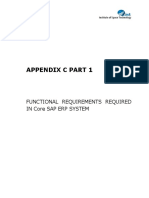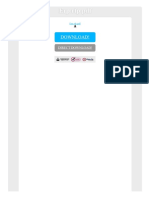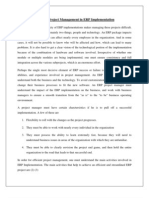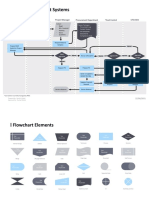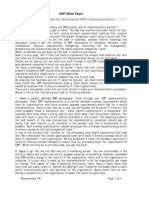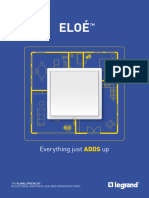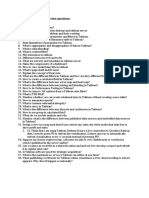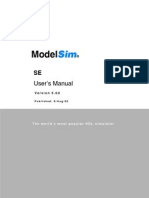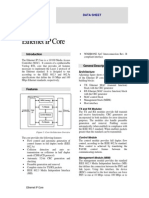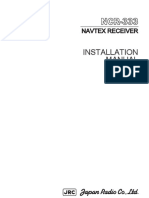ERP IMPLEMENTATION
CHECKLIST
Over 120 actionable steps to a successful and efficient ERP implementation
GUIDE HIGHLIGHTS
Planning your ERP
implementation
Tips on going live, user
training and software testing
Evaluating your ERP
implementation’s success
Page 1 C
ERP FOCUS ERP Implementation Checklist M CONVERTED MEDIA
� INDEX
This checklist breaks down your ERP
implementation into manageable steps across the
following categories
3
Create a change management plan
5
Recruit an ERP implementation team
7
Migrate your ERP data and train users
9
Start your ERP go-live process
10
Evaluate the success of your ERP implementation
Page 2 C
ERP FOCUS ERP Implementation Checklist M CONVERTED MEDIA
� CREATE A CHANGE MANAGEMENT PLAN
Whether you’re upgrading a legacy system or rolling out your company’s first ERP, the potential
impact on the lives of your workforce is huge.
There’s nothing people dislike more than unexpected, unwanted or poorly-managed change, which
is why it is essential that you develop a strong communication strategy and training plan before
implementing your new ERP. This will ensure the process runs smoothly and increase user buy-in
to the system in the long term.
CREATE A CHANGE MANAGEMENT PLAN
Clarify what implementation support your vendor is giving you
Project management
Customization
Data migration
Consultancy
Training
Forecast implementation costs and create an ERP implementation budget
Vendor implementation services
Third-party consultancy
Temporary staff during roll-out
Operations
Shop floor
Administrative
Staff overtime during implementation
Data backup and storage
Identify metrics by which to measure ERP implementation success
Page 3 C
ERP FOCUS ERP Implementation Checklist M CONVERTED MEDIA
� Create a timeline for completing the following steps:
Data migration
User training
Testing
On-the-day go-live activities
CREATE A USER ENGAGEMENT PLAN
Anticipate disruption to everyday activities and let affected employee groups know
Signpost ways in which staff can raise questions or concerns about your new ERP
Create a user training timetable and inform staff of when their slots are in advance
Page 4 C
ERP FOCUS ERP Implementation Checklist M CONVERTED MEDIA
� RECRUIT AN ERP IMPLEMENTATION TEAM
For your project to be a success, you need the right people around you to make it happen. A well-
balanced implementation team should have the right mix of technical and managerial input to get
things done efficiently, and should also be representative of key stakeholder needs across your
organization.
RECRUIT YOUR ERP IMPLEMENTATION TEAM
Map out your implementation team requirements:
Managerial requirements
Technical requirements
Representation requirements
Offer incentives for membership of implementation team and promote them company-wide
Recruit your team:
Recruit technical specialists
Recruit managerial positions
Recruit representatives for key user groups
(Optional) hire third party consultant:
Shortlist candidates
Interview and ask for references
Hire and onboard your consultant
Get budgetary sign off
IMPLEMENTATION TEAM CHECKLIST
Managerial
Project manager
C-level sponsor
Page 5 C
ERP FOCUS ERP Implementation Checklist M CONVERTED MEDIA
� Technical
Application analyst
Application developer
Application test engineer
Consultancy
Third-party consultant OR
Vendor consultant
User group representatives
Shop floor
Engineering
Warehouse
Sales
HR
Supply chain/logistics
Senior management
Heads of department
Page 6 C
ERP FOCUS ERP Implementation Checklist M CONVERTED MEDIA
� MIGRATE YOUR LEGACY ERP DATA AND TRAIN USERS
CLEANSE AND MIGRATE YOUR LEGACY DATA
Before your staff can start using the new ERP system, you need to migrate your data from your
legacy system. It makes sense to ensure it is all up-to-date and accurate whilst doing so - there’s no
point transferring redundant information as this will just clog up your new ERP and increase chance
of error (if you have out-of-date customer addresses saved in your system
CLEANSE AND MIGRATE YOUR LEGACY ERP DATA
Cleanse and verify your data:
Ensure customer contact details are correct
Cleanse redundant internal data, e.g out-of-date product designs and employee info
Cleanse redundant external data, e.g old supplier addresses and customer contacts
Configure your databases
Map legacy data to new database fields
Transfer data to the new system
Test and verify legacy data
Test and verify new data inputs, for example:
Inventory data (item location, stock)
Production data (order volume, parts required, estimated completion date)
Sales data (customer contact, history of orders)
HCM data (payroll information, employee benefits)
TRAIN YOUR MANUFACTURING ERP USERS
User training is essential in encouraging your workforce to engage with your new ERP and not fall
back on the legacy system or develop workarounds. You can only realize the full potential of an ERP
system if people are using it, after all - and without adequate training this is hard to do!
We mentioned coming up with a user training plan in the ‘change management’ section of this
checklist above - here’s a little more detail.
Page 7 C
ERP FOCUS ERP Implementation Checklist M CONVERTED MEDIA
� CREATE AN ERP TRAINING PLAN
Decide which type of training suits your workforce best (e.g e-learning modules for office-
based workforces, scheduled seminars for shop floor workers)
Identify potential super user candidates and train them to assist with troubleshooting
Identify key user groups that need training
Create your training schedule
Decide on deadline for completion of e-learning modules
(OPTIONAL) promote gamified incentives for completion of training
Decide where face-to-face training will take place
Create training schedule for face-to-face training
KEY ERP USER GROUPS CHECKLIST
Senior management
Department managers
Accounting and finance
Engineers
CAD designers
Shop floor workers
Warehouse staff
Supply chain workers
Sales team
HR staff
Page 8 C
ERP FOCUS ERP Implementation Checklist M CONVERTED MEDIA
� START YOUR ERP GO-LIVE PROCESS
There’s one key secret to a successful go-live: planning.
You’ll probably have done some of this already - your users are trained on the new system, your
data is ready and you have the resources ready to carry through your implementation.
Still, the go-live requires a level of organization above all of this, because to put it bluntly, things will
seem a little chaotic until it’s over. Whilst your systems are down, it’s essential that you know who’s
doing what, when they plan on doing it and who to contact when issues arise.
Make sure to communicate any plans to the wider workforce as well as to your implementation
team - if their activities are affected during any downtime, they need to know.
ERP GO-LIVE CHECKLIST
Conduct pre go-live software tests:
Integration testing (eg WMS, PLM, SCM)
Functional testing
System testing
Stress testing
Performance testing
Usability testing with key user groups
Acceptance testing with key user groups - see above
Create a communication plan for on-the-day go-live activities during system downtime
Create and schedule data backup processes
Schedule:
Staff overtime
Temporary staff hours
Network speed and reliability checks
Create plan for evaluating success of ERP implementation project
Conduct post go-live software tests
Page 9 C
ERP FOCUS ERP Implementation Checklist M CONVERTED MEDIA
� EVALUATE THE SUCCESS OF YOUR ERP IMPLEMENTATION
Unless you’ve made a terrible selection choice or you’ve somehow managed to set everything on
fire, you probably won’t need to implement another ERP for a while. You still need to evaluate your
project, as this will help you make adjustments and identify if you’re on track for a positive ROI.
Try to see this as an ongoing process. Your business won’t stand still, so neither should your ERP.
TO CONSIDER IMMEDIATELY POST IMPLEMENTATION
Was your implementation within budget?
Was your implementation within schedule?
Did you have all the resources we needed to complete the project effectively? If not:
Where were there gaps?
How could you fill them?
What went well?
What went wrong, and how can you learn from it?
Are key user groups embracing the new ERP? If not:
Why not?
What is the best way to deliver refresher training?
TO MONITOR CONTINUOUSLY POST IMPLEMENTATION
Have productivity levels increased?
Has client satisfaction increased?
Is human error decreasing (e.g shipment errors, wrong due-date)?
Is your new ERP producing a positive ROI? If so, how many months post-implementation?
Are staff continuing to use the ERP as designed or are they developing workarounds? Consider:
Why not?
What is the best way to deliver refresher training?
Do you need any extra functionality? If so, when should you plan on adding it?
Page 10 C
ERP FOCUS ERP Implementation Checklist M CONVERTED MEDIA
� This guide was written by Rick Carlton and Tom Millers, ERP Focus columnists, with
contributions from Kathryn Beeson, ERP Focus Editor
For more exclusive ERP advice and resources follow ERP Focus on social media:
This guide was brought to you by www.erpfocus.com
Icons made by Freepik from www.flaticon.com is licensed by CC BY 3.0
Page 11 C
ERP FOCUS ERP Implementation Checklist M CONVERTED MEDIA


